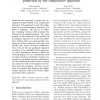Free Online Productivity Tools
i2Speak
i2Symbol
i2OCR
iTex2Img
iWeb2Print
iWeb2Shot
i2Type
iPdf2Split
iPdf2Merge
i2Bopomofo
i2Arabic
i2Style
i2Image
i2PDF
iLatex2Rtf
Sci2ools
125
click to vote
METMBS
2004
2004
An Open Problem in RNA Secondary Structure Prediction by the Comparative Approach
Abstract One approach to predict the secondary structure of RNA is the comparative approach. This approach is used when alignment of several homologous sequences of a RNA is available. The idea is to underline covarying residues which maintain the Watson-Crick complementarity. The main problem of this approach is the selection of homologous sequences to use for the prediction. Indeed, there are many possible combinations of these sequences and only a few number give correct structure predictions. This is due to the low quality of alignment in helices or to variability of the sequences. To select homologous sequences which are correctly aligned, we use evolutionary models under structure constraints. Indeed, constraints on secondary structure should deviate the evolutionary model in helices regions and sequences with correct alignment in helices show this deviation. We have set criteria to underline this deviation and differentiate sequences with correct helices alignment from other seq...
Correct Structure Predictions | Homologous Sequences | Mathematics | METMBS 2004 | Secondary Structure |
Related Content
| Added | 31 Oct 2010 |
| Updated | 31 Oct 2010 |
| Type | Conference |
| Year | 2004 |
| Where | METMBS |
| Authors | Stefan Engelen, Fariza Tahi |
Comments (0)

